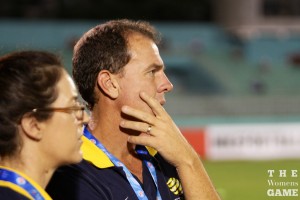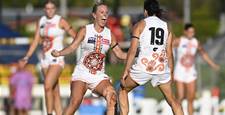Australia and Japan shared the points in the match up of the two favoured teams in this year’s AFC Asian Cup.
Australia and Japan shared the points in the match up of the two favoured teams in this year’s AFC Asian Cup.
Both teams departed the field drained and disappointed in the result, the Matildas’ ruing their best chance since the 2010 Asian Cup semi final to claim full points from the World Champions, having held a 2-0 lead. It was Japan that finished the stronger, peppering Australia’s goal throughout the second half of the match.
Compared to the rowdy, parochial crowd that witnessed Vietnam’s victory over Jordan earlier in the evening, the 2,000 strong crowd on hand to witness the draw was relatively subdued.
Australia dominated the opening half, coach Alen Stajcic asserting that the Matildas “tore them to bits in that first half an hour to be honest. Three or four chances and we could’ve put the game away even then.“ Stajcic conceded “we just need to be more consistent for ninety minutes. Thirty minutes isn’t enough.”
Japan’s much talked about experimental defence struggled to contain the pace of Lisa DeVanna, Teigen Allen and Katrina Gorry in the opening minutes, with DeVanna cracking a shot off the left upright in the second minute, setting the scene for a confident opening stanza.
Emily Van Egmond was strong, floating through the midfield, and Australia’s defence was finding their attacking players at will.
With Australia playing like the favourites, not the underdogs, it was Caitlin Foord’s solo effort in the 20th minute that put the Matildas ahead. Drifting down field with the ball at her feet, her forward partners parted the way for her to slice through as if she was crossing a Ho Chi Minh street in peak hour. She let fly with a clean shot to take the lead.
“Lisa [DeVanna] made a good run out wide so that opened it up for me and I took a touch. Once I hit it I knew it was going in. I don’t think I’ve hit a ball so good before,” Foord said after the match.
To the delight of Matildas’ fans who enjoyed watching Foord create havoc in the forward line with Sydney FC this year in the WLeague, Stajcic selected Foord and De Vanna to run off Heyman.
Only minutes after Foord’s goal, she again took on the Japanese team, weaving through the midfield from her own half. Her attack petered though at the top of the 18 yard box, and this was to be the Matildas’ last dangerous attack until DeVanna extended Australia’s lead against the run of play in the 64th minute.
For Japan, Miyama worked hard in the first half, as did Sakaguchi, but the Matildas continued to swarm. When Japan started to string together their passes, DeVanna and Gorry had to work hard to track back in defence down the left side where Japan were looking dangerous through Nakajima and Takase.
Japan sensed a slowing Australian team, and coach Norio Sasaki threw Ogimi Yuki in up front, replacing Kira in the 35th minute, earlier than planned. The Chelsea striker, due to rejoin her club team in the latter stages of this tournament, wreaked havoc with Australia’s defence. Lydia Williams was called on to make some big saves late in the first half, and was left exposed more than once by her backline.
While the Matildas showed a lot of pace in the first forty minutes, their leg stride shortened and there were hands on hips as Japan were just hitting their stride. Where the Matildas were finding feet in the first 30 minutes with a pinpoint passing game, Japan started dancing through Australia’s central midfield approaching half time, and Australia’s only route was around the edges and long to the corners.
Japan owned the second half, hitting the crossbar in the early minutes. It was against the run of play that Steph Catley overlapped her midfield, collected the ball and delivered a sweet cross into Heyman. She held it up and laid it off to Van Egmond who scuffed her shot, but De Vanna was there to slot it firmly past Yamane Erina in Japan’s goal.
At 2-0 down, but sensing Australia was flagging, Japan’s attacking raids were more frequent and more venomous. Miyama was excellent, Ogimi was toying with the defence, and it was one of many balls across the box that saw Polkinghorne throw a defensive leg out, only to knock it into her own net.
 Lisa De Vanna worked hard in attack and in defence
Lisa De Vanna worked hard in attack and in defenceMore long range shots from Japan peppered Williams’ goal and she did well to hold off the onslaught including a high strike from outside the box that had the tall Australian keeper reaching high to just clutch the ball.
With seven minutes real time remaining, it was Kawasumi, looking like a mini Sawa, who floated a perfect ball to Ogimi, tiptoeing past the Matildas defence and gave Williams no chance to save.
Australia continued to throw players forward, desperately looking for a goal to seal a win. Their best chance came from DeVanna’s dinky chip over the keeper but it just fell wide and couldn’t help the Matildas take the win.
Foord reflected on the result after the game. “We had them there but they came back at the end. I think we’re all a bit disappointed but it’s better to go out with a point than nothing.
"We’re 2-0 up and we let them back in the game there at the end. That’s something we have to work on now, when we are up to keep going and not drop off.”
In his first match as Matildas’ coach, Alen Stajcic had mixed feelings.
“I’m more interested in the performance than the result. We were good for 30 minutes and I thought we let them back in the game towards the end of the first half. They certainly came out firing in the second half . We contained them for a long period but they certainly showed their world class in the second half.
“We had to weather a few storms there but I guess at the end of the day we could have easily won that game and in some instances, maybe could have lost it as well.
“The work rate and the discipline from the team was brilliant.
“It’s a bit disappointing not to get three points but still pretty happy. We started to play with the team discipline and team ethic that we really need.”
Speaking about the team’s strategy, Stajcic was unapologetic about his attacking tactics despite dropping the two goals late in the game.
“Steph Catley set up the second goal so that’s her job in this team now. She has to defend and she has to get forward and create and hopefully we will see more and more of that as the tournament goes along and we get more confident and have a lot more faith in what we’re doing. We had lots of people getting forward and being dangerous.
Caitlin Foord and [Lisa] DeVanna had a few chances as well. And even Michelle [Heyman] held the ball up well for us and Emily [Van Egmond] and Mini [Katrina Gorry] the work rate in the middle.
Everyone did their job today but at the end of the day it was good but it’s not enough. We need to improve if we want to beat them and we’re not going to settle for a point in the future.”
 Coach Alen Stajcic looks on
Coach Alen Stajcic looks onStajcic was clear on the direction this team is headed as long as he is in charge.
“We don’t care if we’re playing world champions, we’re just going to try and win the game all the way through.”
Stajcic proved with Sydney FC this season that he coaches a good fast fizzy game, but what happens when the bubbles run out?
Injecting attacking flair midway through the second half helped sustain the Matildas. It is a style that many of the team will be attuned to having played under Stajcic before. Having a clear mantra and a simple message on and off the field seems to be providing the team a clear direction.
He has chosen a strategy that only the US women’s team employ in world football, and who struggled when Sermanni tried to implement a more patient, possession style game.
This simplicity and role clarity is a strength, particularly with the attacking arsenal the Matildas boast now in DeVanna, Heyman, Foord, Butt, Gill, Sykes, Raso… the list goes on.
But Lydia Williams commented after the match that once Japan cottoned onto Australia’s movement out of the backline, they pressured hard and did not let Australia out of their half. It can be a tiring exercise, chasing down another team who is controlling the midfield, and the Matildas risk this against stronger opposition.
Like a bodybuilder who only works their top half, Australia does not want to be left wanting at the back. They found through dropping two late goals that a porous defence loses you the points that your attack gains.
Van Egmond looked strong in the attacking midfield role, and Gorry started with a burst, but as Japan’s midfield steadied, she found herself chasing, and chasing, and chasing.
Kellond-Knight tired midway through the second half, playing as a deep midfielder, but Stajcic defended his decision to keep her on the field.
“We’re an attacking team so I put attacking changes on. I want to win the game. I don’t want to not lose it so that’s the theme for the team from now on."
We’re going to be positive and proactive. We’re not going to sit on a result. Unless someone is cramping, we’re going to put attackers on and try and win every game. We saw at the end there, we certainly had a couple of chances there to pinch the game. Lisa’s [De Vanna] one that just went over the bar and a couple of other little chances there.”
After the match, the Matildas looked disappointed. Long faces and ice packs strapped to thighs. But on speaking to the players there was a recognition that taking a point from the game was a big achievement, and the draw should send the Matildas into their match against Jordan on an even keel as opposed to the high of a win, or the despair of a missed opportunity.
While Japan are unlikely to be troubled in their upcoming group matches, seeing their depleted squad struggle through the first half hour was tough, although they kept their spirits high and attacked Australia at the first sign of weakness.
 Nahomi Kawasumi was a constant threat on the wings
Nahomi Kawasumi was a constant threat on the wingsTheir backline looked uncomfortable under pressure early in the match, their headchecks frequent as they didn’t seem to have a sense of where Australia’s zippy players were floating, or where their team mates were setting up.
The Matildas tested out left back Utsugi who gave DeVanna far too much room, her basketball style defence leaving her wrong footed on a few occasions and when she did win the ball, she was too off balance to supply quality balls to her midfield. That said, it was Utsugi who sent in a long speculator that floated past Williams into the top netting of the goal, grazing the crossbar and nearly pulling a goal back for Japan.
Come semi-final time, Japan will need to find a backline combination they are comfortable with. Sawa did not see any game time tonight, but she did warm up, indicating that she will play a part in this tournament. Her presence when Ogimi returns to her club side mid-tournament will be a key in leading this relatively inexperienced Japanese side through to the final.
Through 60 minutes, Japan dominated possession and chances, although generally they were shooting from well outside the 18 yard box. Japan missed their European stars who are more likely to penetrate through the backline with deft passes and quick incisive runs. Kawasumi was dangerous down the left, forcing Teigen Allen into desperate, deft tackles, and Nakajima had the Matildas stretched on the right flank.
There is a lot of football to be played between now and the final on 25 May, but lots of minds are imagining what we might be in for if Australia and Japan meet again. It’s going to be good.
Related Articles

'Timing not right': Montemurro's verdict on Matildas vacancy
.jpg&h=172&w=306&c=1&s=1)
Matildas star ready for epic return after 'really difficult' journey













